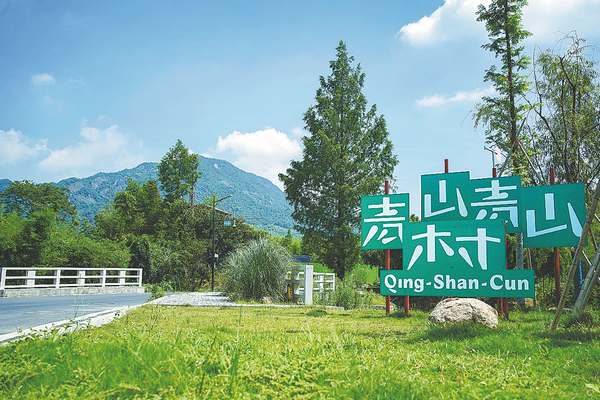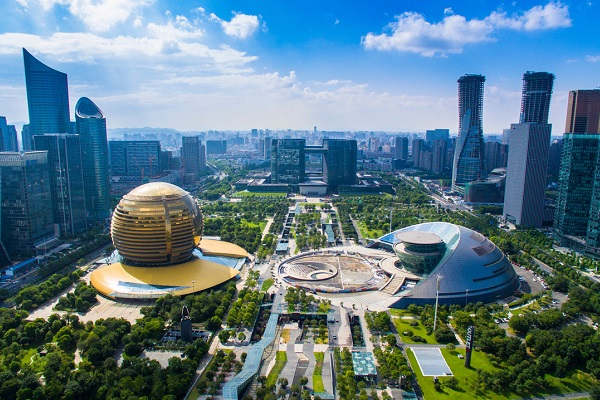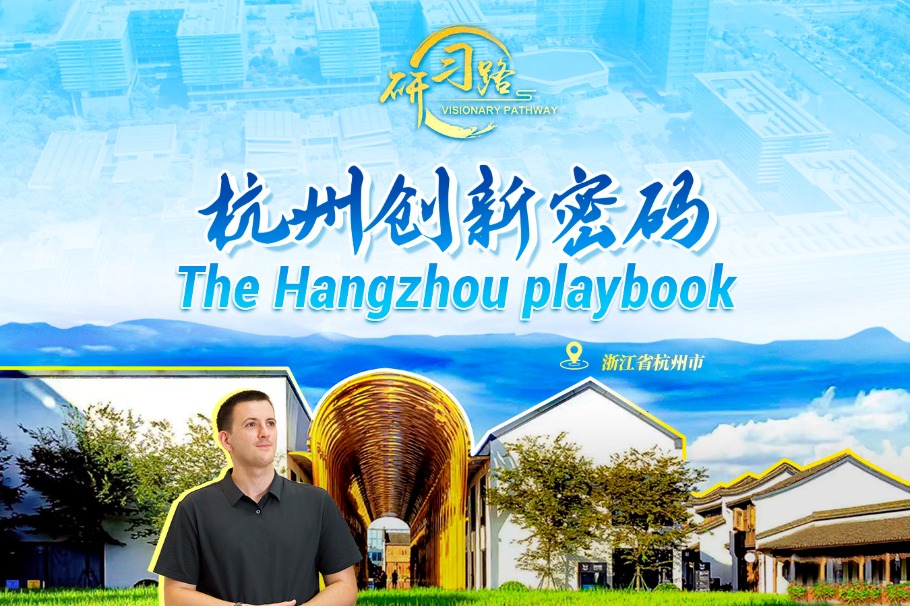Creativity paints a vibrant rural art scene

Artistic elements grace the Qingshan village's sign. CHINA DAILY
Zhejiang villages are among many using culture to revive and embellish country life, Yang Feiyue reports.
Set foot in Qingshan, a village nestled amid lush green mountains, and one is greeted by its artistic vibe.
About 40 kilometers to the northwest of downtown Hangzhou city and in the Yuhang district, of Zhejiang province, Qingshan's roadsides and fields are studded with distinctive art installations.
A nearby dam gives a bird's-eye view of the art, which ranges from vivid paintings and balloons in the shape of eggs to bamboo-woven Mobius strips.
"Each of them has a theme," says Lin Hong, a senior village official.
For example, the egg-shaped piece seeks to increase public awareness of the protection of biodiversity, while the Mobius strip embodies the never-ending symbiosis of bamboo culture and bamboo weaving techniques.
The pieces of public art are scattered throughout every corner of the village, carefully sited in relation to the surrounding environment, and wait for visitors to explore them by foot.
They are some of the 100-odd pieces produced by 160 artists during an art festival held in the village in June and July, which attracted around 40,000 traveler visits.
The village's buildings add traditional craftsmanship to the artistic atmosphere.
"The exterior of the visitor center is wrapped in bamboo, and blends traditional craftsmanship with modern design," Lin says. "It is both aesthetically pleasing and environmentally friendly."
Within walking distance, a design-themed library created inside a disused auditorium enables visitors to appreciate the process of embroidery, lacquer art, woodblock carving and natural dyeing, and to develop a good understanding of the beauty of traditional crafts.
Two of the village's many old buildings have been transformed into art spaces, thanks to a group of craftsmen, artists and curators, who have settled in Qingshan village over the years.
One of the groups, from the Rongsheji craftsmanship workshop, is dedicated to incorporating traditional materials and construction techniques into village buildings.
"We found a lot of creative inspirations in the village," says Zhang Lei, who is in charge of the workshop's operations, and who has been living in Qingshan village for the last five years. "Over the years, team members have come and gone, but in the end, those who have stayed are the ones who truly enjoy rural life."
Efforts by local authorities to improve infrastructure and the rural environment — especially water quality — since 2014, and the encouragement of multi-sector development such as rural tourism, have attracted designers and artists from all over the country.
Zhang has also helped around 30 villagers create woven bamboo artwork, to help increase their incomes.
He is one of many artists to have settled here to get villagers involved in traditional crafts, Lin says.
The handicrafts the artists and villagers have produced together have been shown at exhibitions at home and abroad, including at the Milan Design Week and the Design Shanghai.
"They have also been sold on the market, where they have made twice the profit of similar competitive products," Lin says.
Yu Caiyong, a local embossing artist, says he has been greatly inspired by the incoming artists.
Thanks to their guidance, his bamboo fans, which incorporate paper-cutting elements, stood out at the Hangzhou souvenir creative design competition earlier this year.
With the inflow of experienced artists to Qingshan, its traditional crafts have been given a boost, and the growth of the village's design industry has accelerated the integration of culture and tourism, which has been bringing in around 30,000 visitors a year. Its collective annual income has now risen past 1.5 million yuan ($204,900).
Developments in Qingshan village are part of the efforts by Yuhang district to explore the coexistence between art and rural life, to activate rural resources via artistic means, beautify the rural environment, and empower the village cultural industry.
To date, Yuhang has developed two national-level and two provincial-level art villages. Several other villages are also known for their calligraphy and poetry education.
About an hour's drive to the south, enormous bamboo forests surround Zijing village, which produces about 3 million flutes every year.
Going deeper in the village, a museum in the shape of a music note jumps out. It was built on the site of a former bamboo factory, and now presents a vivid walk through local bamboo and flute history.
Following a storytelling approach, the exhibition hall features interactive videos that bring to life historical objects used in making flutes, including ovens, old-fashioned hole-punching machines, and carving knives, creating an immersive experience. Stories about well-known flute players and craftsmen are also woven in.
The museum regularly organizes activities, including flute recitals and flute-making demonstrations, says Bao Mingyuan, a Zijing village official.
In addition, intangible cultural heritage inheritors and master flute makers are invited to conduct training sessions, enabling the public to be part of the passing on of local culture, Bao adds.
These positive developments have Huang Weidong, a villager, versed in the intangible cultural heritage of flute making, realizing that carrying forward the culture behind the craftsmanship is key to its development.
In recent years, Huang and his fellow flute makers have held livestream sessions to promote flute making and flute culture.
His daughter Huang Yu is also involved in the traditional trade.
After finishing music studies at the Hangzhou Normal University in 2015, she returned to Qingshan to help her father upgrade the family flute business.
Huang Yu has taken charge of production quality, and has tapped into her academic background to found her own flute workshop, where she has taught villagers to both make and play the instrument.
In her spare time, she gives online flute courses to win more fans for her village's specialty.
"My biggest dream is for tourists to hear the melodious rhythms of the flute before they come here," she says.
About 30 km to the northeast of Zijing, calligraphy culture has taken shape in Nanshan village.
Local authorities set up a calligraphy association in 2015, which inspired many villagers to pick up the art form. Nanshan was designated a calligraphy village last year.
Elsewhere in Yuhang, art galleries and homestays of Song Dynasty (960-1279) style have sprung up in Jingshan town, while museums dedicated to textile shuttles and elements of the lunar calendar have been opened in Baizhang town, and a cluster of intangible cultural heritage halls displaying paper umbrellas, kites, jade ware, porcelain, silkworm breeding and mulberry growing have been opened in Pingyao town.
Those artistic endeavors have vitalized rural resources, and helped promote the integrated development of agriculture, culture and tourism, and ultimately, the rural economy.
During the first six months of this year, the collective operating income of villages in Yuhang rose to 506 million yuan, and disposable incomes rose to 30,257 yuan per person, an increase of 6.5 percent year-on-year, according to the district.
The number of agricultural leisure tourists rose to 2.81 million, generating revenues of 425 million yuan.
Chen Dong, who was in charge of the recent art festival in Qingshan village, found that inserting art into the rural landscape can be an effective path toward the sustainable development of rural areas.
"The art festival in Qingshan was not only a celebration for art lovers, but also an excellent opportunity to attract talent and businesses," Chen says.
Contact the writer at yangfeiyue@chinadaily.com.cn
-
Visionary Pathway - Hangzhou Playbook
July 15, 2025



